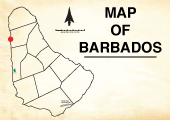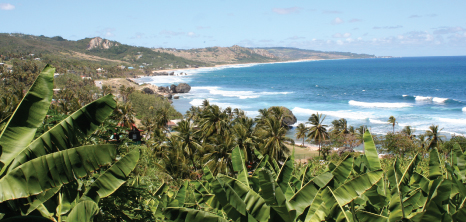|
British ColonisationThough inhabited at least a century earlier by the Spanish and the Portuguese, May 14th, 1625 marked the date that the first English ship touched the shores of Barbados under the command of Captain John Powell. At the time of arrival, the island was uninhabited and Powell returned to England to put plans in place that would see Barbados establishing a permanent settlement osome two years later.
Early Slaves on the IslandOn February 17th, 1627, Captain Henry Powell arrived with a party of 80 British colonists and 10 African slaves to occupy and settle the island of Barbados. This crew landed on the western side of Barbados at a place called Holetown, formerly known as Jamestown.
Despite the fact that there weren't many slaves on the island of Barbados at that time, the contribution made by them was so great that it didn't take long before they were able to hold down a principal position in the financial well-being of Barbados. Their labour-intensive days were made up of some of the most physically enduring tasks such as construction and land debushing.
Formalisation of slaves as the sole property of their slave masters came about in 1636 when a law was passed by colonial officials declaring that all African amd Amerindian slaves brought into Barbados be subjected to slavery for life. Later on, this law was changed a bit to include the offspring of slaves.
Laws Relating to SlavesThe Slave Codes of Barbados provided a legal base as to how slaves should behave and be treated. Despite this, these laws still provided more protection for masters than it did for slaves. These codes served as classic examples for other slave colonies in the Caribbean which passed similar laws in 1664 and 1702, respectively.
By the mid-eighteenth century Barbadian law prohibited slaves from leaving their plantations without permission from their owners and prevented them from beating drums or playing other loud instruments. Barbados further legislated its own version of the Fugitive Slave Law by requiring all whites to return runaway slaves to colonial officials. This law was quite sympathetic toward a master who intentionally killed a slave, requiring him only to pay a fine of only $15. Masters who killed their slaves in what was seen as an inadvertent act, often escaped with no fine.
A Taste of Barbados' Early EconomyThroughout the 17th century in Barbados, European indentured servants were predominantly the suppliers of labour. The production of tobacco and cotton was heavily reliant on these labourers. Both tobacco and cotton plantations saw poor, uneducated labourers who were enlisted from England, Scotland and throughout Europe. Despite the fact that it was stated by the laws of Barbados that these labourers could not be enslaved, they were still seen as being the property of their slave masters.
Harsh working conditions of these slaves created lots of strain and hence saw a drop in both the labour force and Barbados' ability to efficiently produce both tobacco and cotton. The 17th and 18th centuries saw white labourers starting to question their place in the future of Barbados' economy as they began to feel threatened by the increase in African slaves to the island. With no answers and being offered no solutions to their demise, white indentured slaves began to leave Barbados in large numbers and headed to neighbouring islands.
As you can well imagine, an uncomfortable balance resulted for the white plantation owners as they saw the large amounts of remaining blacks to be a potential threat in the light of possible rebellions taking place. Despite this discomfort, they were able to redirect their focus on the bigger picture which was the cheap labour that inevitably led to a lucrative sugar industry.
This discomfort amongst white plantation owners didn't go unnoticed by colonial officials as they responded by establishing white supremacy.
The Advent of the Sugar Industry in BarbadosThe resulting inefficiencies, dwindling work force and tension opened the gates to Barbados struggling to compete with its international competitors. Further weakening of the Barbados economy took place in the early 1640s when a drop in tobacco prices worldwide ensued.
The rapid dwindling of the tobacco and cotton industry forced the planters in Barbados to eagerly explore the possibilities of more lucrative sources of income for the country. Sugar cane was introduced to the agricultural industry on the island in the 1640s by the Dutch as a more thriving alternative to tobacco and cotton. Prior to this formal introduction, sugar was used in Barbados primarily as fuel for rum production and to feed farm animals.
1644 saw large sugar plantations producing sugar across the island to be used for exporting purposes. Sugar production in Barbados skyrocketed to a point where the island manifested itself as a very attractive place of business. The rewarding ventures asociated with the sugar industry in Barbados saw a rise in both land prices and wealthy British investors streaming into the island to embark on the operation of some of these highly profitable sugar plantations.
The advent of the sugar industry in Barbados heavily dominated the island to the point where the history of Barbados and the history of sugar were on a par.
|
 |
|
|


